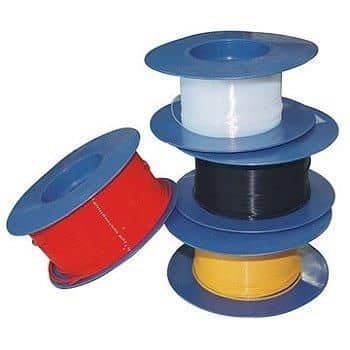Back in the 1900s, the discovery of synthetic plastics opened up ways to create materials that were unlike anything people have ever heard of before. One of them was heat shrink tubing, which was eventually invented by Raychem Corporation in the 1950s. It was a thin thermoplastic sheath that, when exposed to high temperatures, became smaller without melting. It took the shape of the object it surrounded and sealed itself in place.

The product was widely sought after because of its superb insulating properties. Manufacturers used it to coat wires and make lightweight aircraft cables. Today, high-temperature heat shrink tubing has many useful applications, and not just in electrical operations. Learn everything you need to know about the innovative material by reading on.
Using Heat Shrink Tubing
Working with shrink tubing is easy, and you can do it several ways depending on how you’re going to utilize it. If it’s for a DIY project, you can grab a lighter or butane torch and use it to heat the plastic after fitting it to an object.
However, experts discourage the use of these instruments for professional applications so as not to compromise the quality of the work. Get the fire too close, and you risk burning the plastic. For cable manufacturing, electrical system repair, lab equipment insulation, and the like, purchase the proper tools, such as:
Heat Guns – These gadgets shoot hot air and are the primary tool used in shrinking plastic tubing. Engineers, electricians, and computer technicians work with them to do their job safely. They’re very handy, easy to operate, and have attachments that focus the heat on a small area.
Heat Shrink Processing Machines – If you’re manufacturing electrical components or working with 4 AWG power cables or larger, get a shrink tubing processing machine. It applies hot air to thicker thermoplastic sheaths evenly and lessens the risk of overheating them. Its timer automatically powers down the equipment once the job is done.
Choosing the Type of Heat Shrink Tubing
When picking the right shrink tubing, always keep the specifications of your project in mind. You can choose the plastic sleeve based on 2 categories: size and material.
Common Heat Shrink Materials
It’s widely believed that there’s only one kind of shrink tubing and all thermoplastics are the same. But, there’s always the right one for every job. Here are the common materials:
- Polyolefin Tube– You can get this shrink tubing in electrical shops and home improvement stores. It’s one of the most commonly used thermoplastics in households and offices, and it’s also utilized in the railway and aerospace industries. It’s an excellent insulator that can withstand intense heat and high-power voltages.
- PVC Tube– Polyvinyl chloride or PVC tubing is the cheaper alternative to polyolefin, and while it can’t withstand high temperatures, it has better tensile strength and abrasion resistance. It also has more vibrant colors, so it’s best to use for color-coding cables.
PTFE Tube– Polytetrafluoroethylene or heat shrink PTFE tubing has high corrosion and chemical resistance, plus it functions efficiently in a wide range of temperatures. It’s commonly used in labs, medical equipment, and electrical and automotive applications.
Heat Shrink Tubing Sizes and Shrink Ratio
The size of a thermoplastic tubing refers to its diameter, and it goes hand in hand with the shrink ratio. It’s commonly available in 2:1 or 3:1, which means the sleeve becomes smaller by 2 or 3 times its original dimension. Irregularly shaped objects require a higher shrink ratio.
Choosing the right ones for your project ensures that they’ll have a snug fit. Refer to the list below for the recommended shrink tubing dimensions for common cable sizes:
- 28 to 30 AWG wiring – 3/64 tubing with 2:1 shrink ratio
- 22 to 30 AWG wiring – 1/16 tubing with 2:1 shrink ratio
- 16 to 26 AWG wiring – 3/32 tubing with 2:1 shrink ratio
- 16 to 22 AWG wiring – 3mm tubing with 2:1 shrink ratio
- 10 to 14 AWG wiring – 5 or 6mm tubing with 2:1 shrink ratio
- Less than 10 AWG wiring – 8mm tubing with 2:1 shrink ratio
Now that you know the basics, you can confidently choose one that’s right for your project. Get in touch with Tef – Cap Industries Inc. for a wide selection of heat shrinkable PTFE tubing and other thermoplastics.
